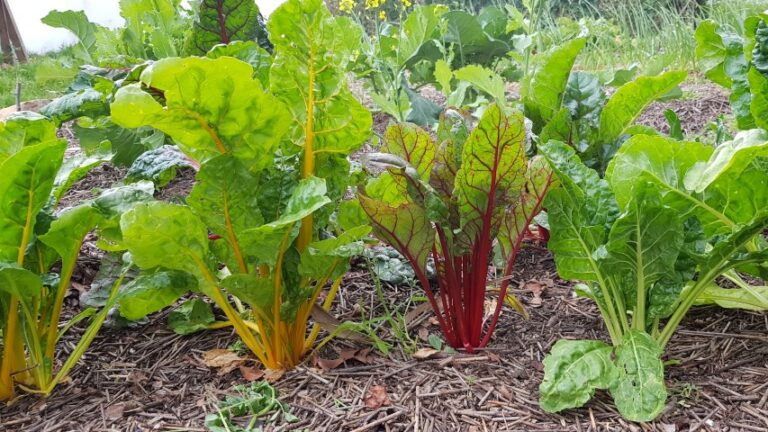Swiss chard (Beta vulgaris var. cicla), the often overlooked but delightful biennial vegetable, deserves a spot in our garden next to your tomatoes, pumpkins, or gingers. Despite being overshadowed by its close relatives, spinach and beets, Swiss chard is a versatile and easy-to-grow plant that will add color and flavor to your dishes.
Its large, thick, ruffled leaves come in various colors, including vibrant shades of pink, red, and yellow, with contrasting veins that make for a striking visual. Plus, the leaves keep growing as you harvest them, ensuring a steady supply for your cooking needs. With a fast growth rate and the ability to thrive in mild temperatures, Swiss chard can be planted in the early spring or late summer for a bountiful harvest.
Common Swiss Chard varieties:
- Bright Yellow
- Bright Lights
- Lucullus
- Fordhook Giant
- Rhubarb Chard
- Ruby
- Rhubarb Red
Care
Caring for Swiss chard is not too difficult, and it’s definitely worth the effort. With a little bit of care, you’ll be able to enjoy a bountiful harvest of this nutritious and delicious vegetable! Here are a few things you should pay attention to:
- Soil: It needs a well-draining, organically rich soil with a slightly acidic pH. To prevent rotting, it’s crucial not to let the plant sit in water for too long.
- Sun: This vegetable plant prefers full sun, but thankfully, it can also tolerate some shade.
- Water: Watering regularly and keeping the soil evenly moist is crucial, but be sure not to overwater and make the soil too soggy.
- Temperature: With regards to temperature and humidity, Swiss chard can handle very light frost, but it won’t survive extended periods of freezing temperatures.
Propagation
It’s an easy plant to grow, whether you choose to grow it in the ground, in containers, or even from cuttings. You can start with strong, vigorous Bonnie Plants, and they can tolerate both cool and hot temperatures, making them versatile vegetables.
To harvest Swiss chard, you can cut the leaves with kitchen shears just above the soil line when they are around 6 inches long. The plant will quickly regrow, and you’ll have another crop in just 7-10 days. To ensure good growth, give each seedling about 12 inches of space, with a gap of 18 inches between rows, and keep the soil evenly moist without letting it dry out completely. With proper care, you can have a continuous harvest of this delicious and healthy vegetable!
Common Pests
Frequently Asked Questions
Swiss chard is a colorful, leafy green that’s actually a beet bred for its edible stems and leaves. People often use it as a substitute for spinach in recipes.
Where does Swiss chard grow best?
Swiss chard grows best in a location with full sun exposure and well-drained, slightly acidic soil. It can tolerate both cool and hot temperatures and can be grown in most USDA hardiness zones.
How long will Swiss chard keep growing?
Swiss chard grows at a speedy rate, and you can typically start harvesting it just four to six weeks after planting.
What month is best to plant Swiss chard?
Swiss chard can be planted in early spring or late summer when temperatures are mild and pleasant. In general, this means planting between March to May or August through September. However, it’s worth noting that the best time to plant Swiss chard may vary depending on your location and climate.
